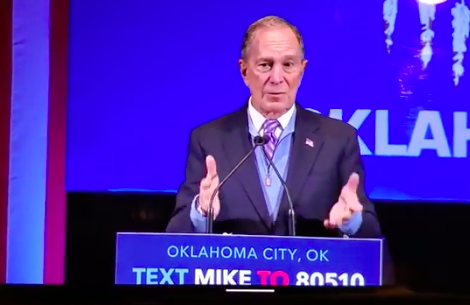
- Details
- By Levi Rickert
OKLAHOMA CITY, Okla. - Former New York City Mayor Mike Bloomberg, who is running for the Democratic party’s presidential nomination, held a small rally to roll out his Native American plan last Thursday in Oklahoma City.
As reported here last Friday, Bloomberg’s plan would reverse historical injustices, affirm tribal sovereignty and protect the most vulnerable Native Americans from assault, attacks on voting rights and health disparities.
While presenting his plan, Bloomberg left his script and spoke about the Savannah’s Act legislation in the U.S. Senate to combat violence against women, and said:
"There is a Native American tribe right near where I live, the Shinnecock Nation. It is just a disaster. There's all sorts of problems . . . I will help them as well, because we just can't have a group where there's all the domestic violence and drugs and alcoholism. We've just got to do something."
His comments drew applause from those assembled.
"When you see that, you've got to say something's wrong, and then we've got to stop it, and actually give them some services, rather than just talking about it,” Bloomberg continued.
Back in New York, Bloomberg’s comments drew the ire citizens of the Shinnecock Nation, which is located on Long Island.
“Our Nation and myself are really appalled at Bloomberg’s choice of words in using the Shinecock Nation as one of his references in trying to impress Indian Country and to make them think he is really going to do something for Indian Country,” Shinnecock Nation Vice Chairman Lance Gumbs told Native News Online in an interview at the National RES in Las Vegas on Monday.
Gumbs, who also serves as alternate regional vice president of the National Congress of American Indians, spent a major part of his Monday answering telephone calls from The New York Times, the New York Post and local New York media.
Gumbs said Bloomberg purchased a mansion near the Shinnecock Nation in the Hamptons a number of years ago, but has never once visited and really has no first hand knowledge of what goes on there.
“He has a house on stolen Shinnecock territory, but never has set his foot on where we live today,” Gumbs said.
“The mayor has a history of making off the cuff comments about Native Americans, He made that statement in 2009 about ‘cowboy hats and shotgun’ when talking about tax wars we were (tribes) were having with the state of New York,” Gumbs said.
“So for him to talk about us as if he knows us is really insulting to our citizens who get up and go to work everyday. While some people may drink, we don’t have an alcohol problem. We don’t have a drug problem. And, we have never had a domestic violence problem like he said we do,” Gumbs stated. “It’s wrong for him to lump us together as if we are part of some stereotype disaster.”
Gumbs said he has reached out to the Bloomberg presidential campaign to express his anger at the former mayor’s comments, but has not heard back from anyone.
More Stories Like This
Native News Weekly (August 25, 2024): D.C. BriefsUS Presidents in Their Own Words Concerning American Indians
Native News Weekly (December 14, 2025): D.C. Briefs
Wounded Knee Massacre Site Protection Bill Passes Congress
Two Murdered on Colville Indian Reservation
Help us defend tribal sovereignty.
At Native News Online, our mission is rooted in telling the stories that strengthen sovereignty and uplift Indigenous voices — not just at year’s end, but every single day.
Because of your generosity last year, we were able to keep our reporters on the ground in tribal communities, at national gatherings and in the halls of Congress — covering the issues that matter most to Indian Country: sovereignty, culture, education, health and economic opportunity.
That support sustained us through a tough year in 2025. Now, as we look to the year ahead, we need your help right now to ensure warrior journalism remains strong — reporting that defends tribal sovereignty, amplifies Native truth, and holds power accountable.
 The stakes couldn't be higher. Your support keeps Native voices heard, Native stories told and Native sovereignty defended.
The stakes couldn't be higher. Your support keeps Native voices heard, Native stories told and Native sovereignty defended.
Stand with Warrior Journalism today.
Levi Rickert (Potawatomi), Editor & Publisher

